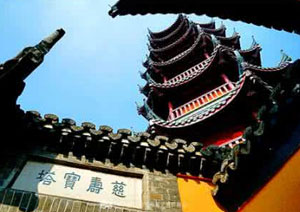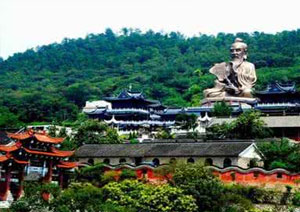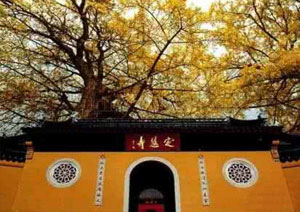 Jinshan Temple locates on the top of Jinshan Hill in the center of Jinshan Park. Jinshan Park is a national 4-A tourist attraction and gains its fame mainly because of Jinshan Temple, which enjoys a history of more than 1,600 years and has the most places of interests with beautiful scenery as well as legends and stories. The most famous legend about Jinshan Temple is the "Tale of White Snake". In the tale the white snake changed herself into a beautiful girl, named Bai Suzhen, after thousands of years' asceticism and married a man Xu Xian. A monk named Fahai tricked Xuxian to become a monk to separate the couple but Xu Xian escaped from Jinshan Temple. Fahai then confined Baisuzhen under the Jinshan Temple and caused a big fighting as "Water wraps Jinshan Temple". Now the story goes on and spreads widely.
Jinshan Temple locates on the top of Jinshan Hill in the center of Jinshan Park. Jinshan Park is a national 4-A tourist attraction and gains its fame mainly because of Jinshan Temple, which enjoys a history of more than 1,600 years and has the most places of interests with beautiful scenery as well as legends and stories. The most famous legend about Jinshan Temple is the "Tale of White Snake". In the tale the white snake changed herself into a beautiful girl, named Bai Suzhen, after thousands of years' asceticism and married a man Xu Xian. A monk named Fahai tricked Xuxian to become a monk to separate the couple but Xu Xian escaped from Jinshan Temple. Fahai then confined Baisuzhen under the Jinshan Temple and caused a big fighting as "Water wraps Jinshan Temple". Now the story goes on and spreads widely.
 Jiaoshan Hill is located about 4.5 km northeast of Zhenjiang City in the middle of Yangtze River with its beautiful greenery and is compared to a piece of floating jade hill, hence gains its another name "Floating Jade Hill". Actually, this hill has gained many names in history such as Lion Hill, Lion cave, Double Peak Hill and so on because of its looks and appearance. It was originally named "Qiao Hill" after Qiao Guang, the famous hermit in Eastern Han Dynasty who once lived in the hill. In order to memory this famous hermit, Emperor Zhenzong of the Song renamed the hill as Jiao Hill.
Jiaoshan Hill is located about 4.5 km northeast of Zhenjiang City in the middle of Yangtze River with its beautiful greenery and is compared to a piece of floating jade hill, hence gains its another name "Floating Jade Hill". Actually, this hill has gained many names in history such as Lion Hill, Lion cave, Double Peak Hill and so on because of its looks and appearance. It was originally named "Qiao Hill" after Qiao Guang, the famous hermit in Eastern Han Dynasty who once lived in the hill. In order to memory this famous hermit, Emperor Zhenzong of the Song renamed the hill as Jiao Hill.
Jiaoshan Hill enjoys its fame for the well-known sites there including Dinghui Temple, Forest of Stone tablets, Cliff of Scripts, Emperor Qianlong's Xanadu and so on. Among them the most famous are Dinghui Temple and Cliff of Scripts.
 Mao Mountain is located in the southeastern part of Gourong city, Jiangsu province. The Taoism has made it a famous Taoism mountain in Chinese history. There are many Taoist Temples in this mountain and the name of mountain is also linked with the Taoism. The legend goes that in the reign of Emperor Jingdi of the Han dynasty (206BC-220 AD), there are three brothers named Mao Ying, Mao Gu and Mao Zhong. They cultivated themselves at this place and treated diseases for the people and they obtained the Tao and attained immortality after that. The later generations renamed the mountain as Three Mao Brothers Mountain in memory of them. Today, people also call it Mao Mountain as a memorization of them.
Mao Mountain is located in the southeastern part of Gourong city, Jiangsu province. The Taoism has made it a famous Taoism mountain in Chinese history. There are many Taoist Temples in this mountain and the name of mountain is also linked with the Taoism. The legend goes that in the reign of Emperor Jingdi of the Han dynasty (206BC-220 AD), there are three brothers named Mao Ying, Mao Gu and Mao Zhong. They cultivated themselves at this place and treated diseases for the people and they obtained the Tao and attained immortality after that. The later generations renamed the mountain as Three Mao Brothers Mountain in memory of them. Today, people also call it Mao Mountain as a memorization of them.
 Dinghui Temple, first built in the Eastern Han Dynasty (25 - 220), is the largest of all the temples on Jiaoshan Hill. It was originally named Puji Temple and was renamed as Puji Buddhist Temple in the Song Dynasty and Jiaoshan Temple in the Yuan Dynasty. During the Qing Dynasty (1644 - 1911), when Emperor Kangxi made a tour of this mountain, its named was changed to Dinghui Temple, the one we used today. The temple lies on the hill and is magnificent in scale. During the Ming Dynasty (1368 - 1644) when it reached its golden ages, it has 98 halls, 3000 monks and 18 additional temples beside it. The mountain gate of Dinghui Temple, simple and elegant, was open to the south. A pair of stone lion dated from the Ming Dynasty guards the gate and a tablet written with "Dinghui Temple in Jiaoshan" was hung above the gate.
Dinghui Temple, first built in the Eastern Han Dynasty (25 - 220), is the largest of all the temples on Jiaoshan Hill. It was originally named Puji Temple and was renamed as Puji Buddhist Temple in the Song Dynasty and Jiaoshan Temple in the Yuan Dynasty. During the Qing Dynasty (1644 - 1911), when Emperor Kangxi made a tour of this mountain, its named was changed to Dinghui Temple, the one we used today. The temple lies on the hill and is magnificent in scale. During the Ming Dynasty (1368 - 1644) when it reached its golden ages, it has 98 halls, 3000 monks and 18 additional temples beside it. The mountain gate of Dinghui Temple, simple and elegant, was open to the south. A pair of stone lion dated from the Ming Dynasty guards the gate and a tablet written with "Dinghui Temple in Jiaoshan" was hung above the gate.
| Zhenjiang Attractions List | |

